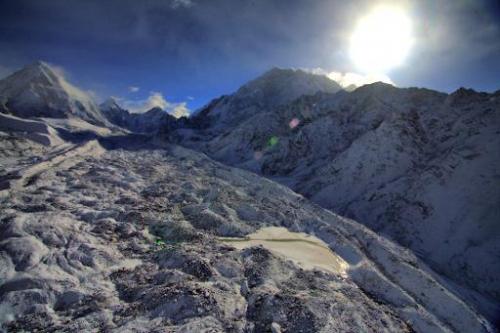Nepal Glaciers Shrink By Quarter In 30 Years
By Countercurrents
24 May, 2014
Countercurrents.org

This file picture taken on May 11, 2009 shows the Khumbu glacier in the Everest-Khumbu region, one of the longest glaciers in the world. Source: phys.org
Climate crisis has caused Nepal 's Himalayan glaciers to shrink by nearly a quarter in just over 30 years, said a scientist.
The glacier loss raises the risk of natural disasters in the ecologically fragile region.
A new study by the Kathmandu-based International Centre for Integrated Mountain Development (ICIMOD) shows that the area covered by glaciers has decreased by 24 per cent between 1977 and 2010.
Samjwal Ratna Bajracharya, lead author of the report, said the shrinking of glaciers in Nepal is definitely connected to climate change; glacial melt is a huge indicator of rising temperatures.
Under the three-year study led by ICIMOD scientists mapped satellite imagery from several decades to find the extent of ice loss in the region.
The fastest decline occurred between 1980 and 1990, said Bajracharya. Prior to the late 1970s, satellite imagery reflected little change in Nepal 's glacial area.
He said the glacial melting is creating huge, expanding lakes that threaten to burst and devastate mountain communities living downstream.
The accelerated glacial loss raises concerns over future access to water resources, particularly in regions where groundwater is limited and monsoon rains are erratic.
If the trend continues, the immediate impact will be felt by those living in high-altitude regions, which are dependent on freshwater reserves from glaciers, said Bajracharya.
The findings also sound alarm bells for Nepal 's push to develop hydropower projects.
Nepal cannot use its water resources to develop the country without assessing the state of our glaciers and river basins, he said.
A government report in India recently blamed hydropower projects for devastating floods last year that killed thousands in India and Nepal .
The government panel said the build up of sediment in rivers, due to the dumping of soil that was dug up during construction of hydropower projects, exacerbated flooding when record-high rainfall hit the region last June.
It should be mentioned that the Himalayan region abounds in glaciers. Most of the big glaciers lie in the eastern Himalayas .
As the western Himalayas receive only a small amount of rainfall, barring the formation of vast snowfields, the source of some of the big rivers of Nepal are in fact glaciers.
Nepal 's largest glacier lies in the Mahalangur and the Kumbhakarna ranges. Khumbu is the biggest glacier and Langtang the longest. Kanchenjunga , Yalung, Nupchu and Langtang are some other glaciers belonging to the eastern Himalayas . Tukche and Hidden valley glaciers belong to the central Himalayas but these are comparatively small.
The Khumbu glacier is situated between Mount Everest and the Lhotse-Nuptse Ridge. It is seen flowing down between the two mountains and swerving right through the Khumbu valley. The terrain is gray and rocky.
Comments are moderated

